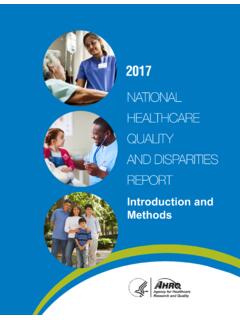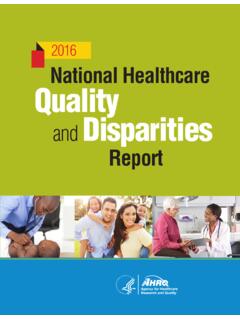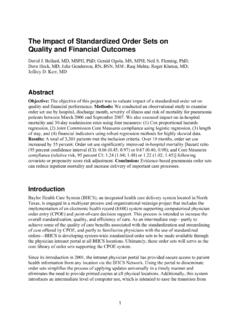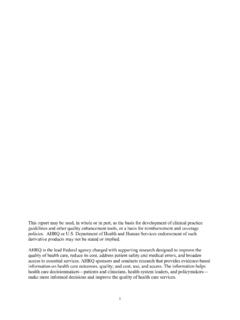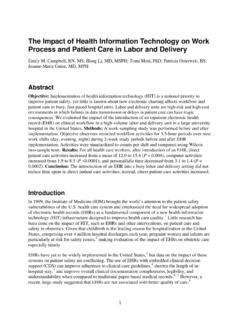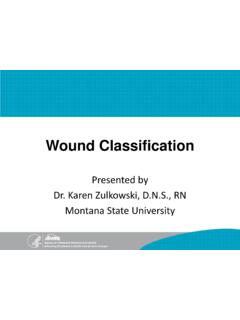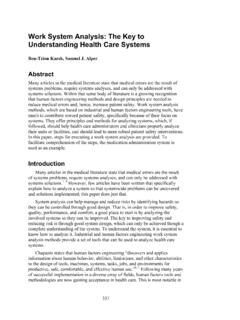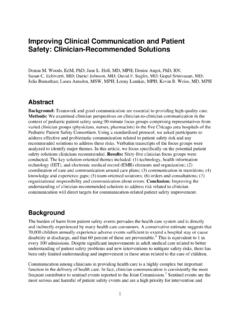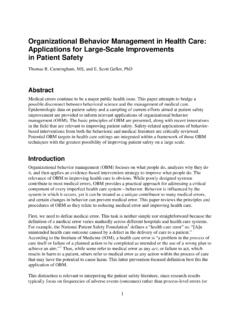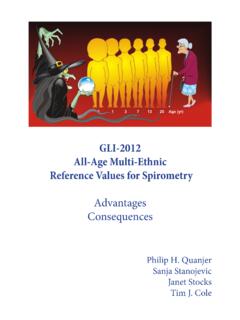Transcription of Fact Sheet on Patient Safety Indicators
1 Toolkit for Using the AHRQ quality Indicators How To Improve Hospital quality and Safety 1 Tool Fact Sheet on Patient Safety Indicators What Are the Patient Safety Indicators ? The Patient Safety Indicators (PSIs) are a set of 26 Indicators (including 18 provider-level Indicators ) developed by the Agency for Healthcare Research and quality (AHRQ) to provide information on Safety -related adverse events occurring in hospitals following operations, procedures, and childbirth. The PSIs were developed after a comprehensive literature review, analysis of available ICD-9-CM1 codes, review by a clinician panel, implementation of risk adjustment, and empirical analyses. The PSIs use administrative data in the typical hospitalization discharge record to identify potential in-hospital complications. The provider-level Indicators can be used to help hospitals identify adverse events worthy of further study and to assess the incidence of such events for comparative purposes.
2 Some of these Indicators also have area-level analogs designed to detect Patient Safety events on a county or regional level. PSI 90 is a composite measure that is intended to reflect the Safety climate of the hospital by providing a marker of Patient Safety (or avoidance of harm ) during the delivery of health care. As a single and transparent metric, it can be easily used to monitor performance over time or across regions and populations using a methodology that can be applied at the national, regional, State, and provider level. Each PSI in the the PSI 90 composite is amenable to prevention through system-level related structures and processes of care. The PSI 90 composite indicator is intended to be used primarily to monitor performance in national and regional reporting, and also for comparative reporting and quality improvement at the provider level. It is not intended to reflect any broader construct of quality , beyond what is reflected in the component Indicators themselves.
3 Use of a composite can assist consumers in selecting hospitals, assist clinicians in allocating resources, and assist payers in assessing performance; especially in the presence of competing priorities or where than more than one component measure may be important. A Snapshot of the Indicators The current provider-level PSIs are listed in Table 1, along with information on their 2012 annual rates and status regarding NQF endorsement. A detailed list of indicator specifications, software for calculating the measures, and software documentation are available on the AHRQ quality Indicators Web site: 1 ICD-9 = International Classification of Diseases, 9th Revision. Toolkit for Using the AHRQ quality Indicators How To Improve Hospital quality and Safety 2 Tool Table 1. The 2015 AHRQ Provider-Level Patient Safety Indicators (PSIs), With 2012 Rates and National quality Forum Endorsement Status NQF Endorsement Patient Safety Indicator Area-Level Indicator Observed Rate per 1,000 NQF Nbr Most Recent Year PSI 02 Death Rate in Low-Mortality Diagnosis-Related Groups (DRGs) 0.
4 32 0347 2012 PSI 03 Pressure Ulcer Rate PSI 04 Death Rate Among Surgical Inpatients with Serious Treatable Complications 0351 2012 PSI 05 Retained Surgical Item or Unretrieved Device Fragment Count X N/A* 0363 2012 PSI 06 Iatrogenic Pneumothorax Rate X 0346 2012 PSI 07 Central Venous Catheter-r elated Bloodstream Infection Rate X PSI 08 Postoperative Hip Fracture Rate PSI 09 Perioperative Hemorrhage or Hematoma Rate X PSI 10 Postoperative Physiologic and Metabolic Derangement Rate PSI 11 Postoperative Respiratory Failure Rate 0533 2009 PSI 12 Perioperative Pulmonary Embolism or Deep Vein Thrombosis Rate 0450 2012 PSI 13 Postoperative Sepsis Rate PSI 14 Postoperative Wound Dehiscence Rate X PSI 15 Accidental Puncture or Laceration Rate X 0345 2012 PSI 16 Transfusion Reaction Count X N/A* 0349 2012 PSI 17 Birth Trauma Rate Injury to Neonate PSI 18 Obstetric Trauma Rate vaginal delivery with instrument PSI 19 Obstetric Trauma Rate vaginal delivery without instrument PSI 90 Patient Safety for Selected Indicators ** 0531 2015 *N/A: Not applicable, measure is based on a count of events.
5 ** Composite measure Based on AHRQ QI software version for ICD-9 , as of March 2015; 2012 is the most recent version of HCUP available at time of toolkit publication. Source: Agency for Healthcare Research and quality (AHRQ), Healthcare Cost and Utilization Project (HCUP) State Inpatient Databases (SID), 2012 ; AHRQ quality Indicators Patient Safety Indicators Benchmark Data Tables. AHRQ quality Indicators software AHRQ provides free software in both SAS and Windows for organizations to apply the PSIs to their own data to assist quality improvement efforts in acute care hospital settings. Both versions of the software include all the AHRQ QI modules, including the PSIs. Many of the PSIs are calculated using present on admission (POA) codes in the hospital discharge data. In QI software version , the user had the option of indicating that POA should not be Toolkit for Using the AHRQ quality Indicators How To Improve Hospital quality and Safety 3 Tool considered when running the software .
6 In version , the option to ignore POA was removed. It is now assumed that all data include valid POA information. In October 2015, the International Classification of Diseases, Ninth Revision, Clinical Modification (ICD-9-CM) used to report medical diagnoses and inpatient procedures was officially replaced by the International Classification of Diseases, Tenth Revision, Clinical Modification (ICD-10-CM). This transition affected diagnosis and inpatient procedure coding across the United States. As of spring 2016, AHRQ has updated the QI software ( ) to account for the change to ICD-10. Because hospitals have just begun coding with ICD-10 codes, there are no available national data that allow hospitals to compare their measures to national benchmarks; however, future versions of the software will calculate risk-adjusted measures.
